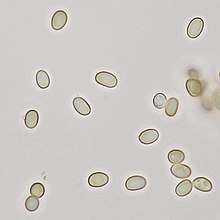Boletinellus merulioides
Boletinellus merulioides, commonly known as the ash-tree bolete, is a species of bolete fungus in the family Boletinellaceae . Described as new to science in 1832, it is found in Asia and eastern North America, where it grows on the ground near ash trees.
| Boletinellus merulioides | |
|---|---|
_Murrill_247594.jpg) | |
| Scientific classification | |
| Kingdom: | |
| Division: | |
| Class: | |
| Order: | |
| Family: | |
| Genus: | |
| Species: | B. merulioides |
| Binomial name | |
| Boletinellus merulioides (Schwein.) Murrill (1909) | |
| Synonyms[1] | |
Taxonomy
The species was first described as Daedalea merulioides by Lewis David de Schweinitz in 1832, from collections made in Salem.[3] William Alphonso Murrill transferred the species to the genus Boletinellus in 1909.[4] It is commonly known as the "ash-tree bolete".[5] Rolf Singer classified it in the genus Gyrodon, but it is not closely related to that genus genetically.[6]
Description
The cap is initially convex before becoming flattened to convex in maturity, and attains a diameter of 5–12 cm (2.0–4.7 in). The cap surface is dry to slightly sticky, and smooth or covered with tiny fibrils. Its color ranges from yellow brown to reddish brown, and will bruise dull yellow-brown. The flesh is yellow and, when cut, will either have no color reaction or change slowly to blue-green. It has no distinctive taste or odor. The pore surface is pale yellow to dull gold or olive, but will slowly turn blue and then reddish brown as a reaction to injury. The pores are boletinoid, meaning that they have a structure intermediate between gills and pores. They are about 1 mm wide, and the tube layer is 3–6 mm (0.12–0.24 in) deep.[5]

The fruit bodies are edible but of low quality.[7] The mushrooms can be used in mushroom dyeing to produce light brown or dark orangish brown colors, depending on the mordant used.[8]
Ecology and distribution
Fruit bodies of Boletinellus merulioides grow on the ground scattered or in groups, almost always near ash (Fraxinea spp.), but rarely near maple and white pine.[5] Unusual for boletes, it forms abundant sclerotia. These are spherical to roughly elliptical structures measuring 2–3 mm wide, which have a hard, black to dark brown rind and a hollow internal medulla. Occurring singly or in clumps of over 100, they are usually found between the mineral and organic layers of the soil. The sclerotia allow the fungus to survive harsh conditions such as low temperatures, and will rapidly colonize nearby soil when conditions are favorable.[9] The fungus's preference for growing near ash is not due to a mycorrhizal association between them, but rather because the fungus has a relationship with a parasitic aphid that occurs only on these trees. The aphid feeds on the tree roots, and shelters inside hollow sclerotia formed by the fungus in the soil, or attached to the root system. The aphid secretes carbohydrates and other nutrients that benefit the fungus.[10]
The fungus is found in eastern North America, from eastern Canada south to Alabama and west to Wisconsin. It is also found in Mexico. A common species, it fruits in summer and autumn.[5] It has also been reported in Asia (Japan).[11]
See also
References
- "Boletinellus merulioides (Schwein.) Murrill 1909". MycoBank. International Mycological Association. Retrieved 2012-10-10.
- Singer R. (1938). "Sur les genres Ixocomus, Boletinus, Phylloporus, Gyrodon et Gomphidius. 2. Les Boletinus". Revue de Mycologie (in French). 3 (4–5): 157–77.
- von Schweinitz LD. (1832). "Synopsis fungorum in America boreali media degentium". Transactions of the American Philosophical Society. 4 (2): 141–316 (see p. 160). doi:10.2307/1004834.
- Murrill WA (1909). "The Boletaceae of North America – 1". Mycologia. 1 (1): 4–18. doi:10.2307/3753167.
- Bessette AE, Roody WC, Bessette AR (2000). North American Boletes. Syracuse, New York: Syracuse University Press. p. 187. ISBN 978-0-8156-0588-1.
- Kretzer A, Bruns TD (1999). "Use of atp6 in fungal phylogenetics: An example from the Boletales" (PDF). Molecular Phylogenetics and Evolution. 13 (3): 483–492. doi:10.1006/mpev.1999.0680. PMID 10620406.
- Phillips, Roger (2010). Mushrooms and Other Fungi of North America. Buffalo, NY: Firefly Books. p. 275. ISBN 978-1-55407-651-2.
- Bessette A, Bessette AR (2001). The Rainbow Beneath my Feet: A Mushroom Dyer's Field Guide. Syracuse, New York: Syracuse University Press. p. 46. ISBN 0-8156-0680-X.
- Cotter HV, Miller OK Jr (1985). "Sclerotia of Boletinellus merulioides in nature". Mycologia. 77 (6): 927–931. doi:10.2307/3793304. JSTOR 3793304.
- Brundrett MC, Kendrick B (1987). "The relationship between the ash bolete (Boletinellus merulioides) and an aphid parasitic on ash tree roots". Symbiosis. 3 (3): 315–320.
- Nagasawa E. (2001). "Taxonomic studies of Japanese boletes. I. The genera Boletinellus, Gyrodon and Gyroporus". Reports of the Tottori Mycological Institute (in Japanese) (39): 1–27. ISSN 0388-8266.